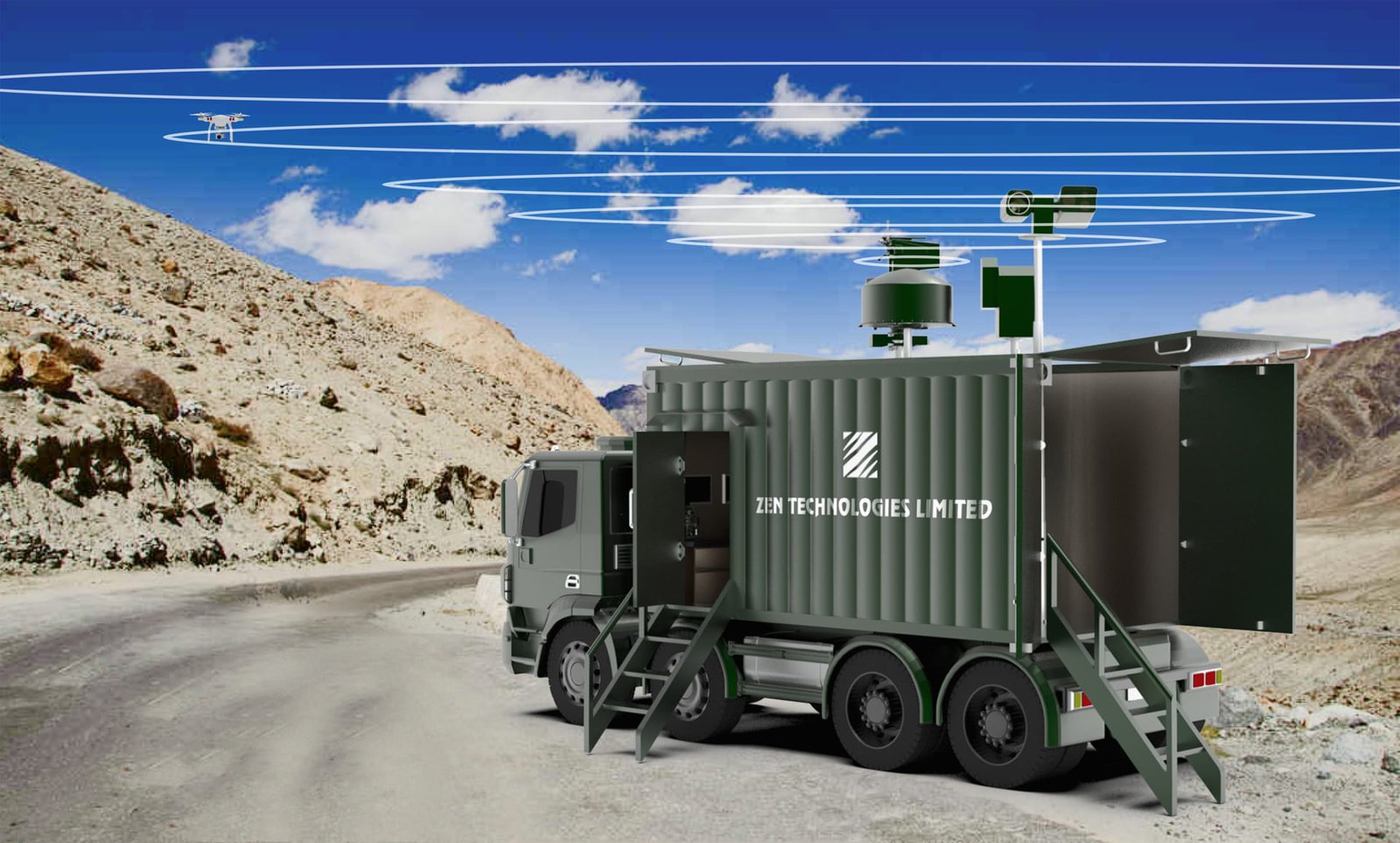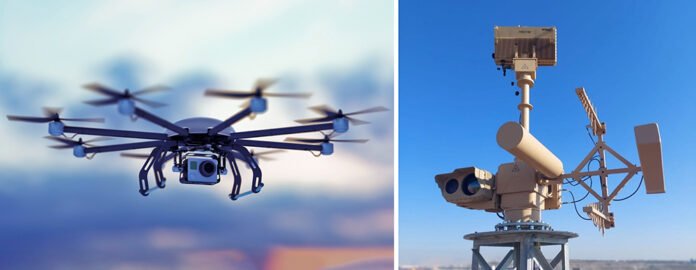The world is witnessing a dramatic transformation in the skies. Unmanned Aerial Systems (UAS), also known as drones, have evolved from niche military tools into powerful, multi-purpose machines that are reshaping industries, redefining warfare, and revolutionising recreation. Their applications range from precision agriculture and logistics to surveillance and targeted strikes. Affordable, compact and technologically advanced, drones are now everywhere — but so are the threats they pose.
However, alongside legitimate uses, rogue actors have weaponised drones for terror attacks, cross-border smuggling and unauthorised surveillance — making the need for effective Counter-Unmanned Aircraft Systems (C-UAS) solutions more urgent than ever before. This has sparked a fast-paced technological duel: drones versus drones — a modern sword-and-shield arms race. And India, with its booming tech sector and growing defence capabilities, is rapidly transforming into a major player on both sides.
India’s Contributions to Drone Technology
India has made significant strides in drone development, driven by its growing defence and technology sectors. Prominent among them are:
Defence Research and Development Organisation: The DRDO has developed indigenous drones, such as the Rustom series, designed for surveillance and reconnaissance. The Tapas-BH (Tactical Airborne Platform for Aerial Surveillance-Beyond Horizon) is a medium-altitude, long-endurance (MALE) drone capable of operating for over 24 hours.
Private Sector Innovation: Indian startups such as IdeaForge have manufactured lightweight, high-endurance drones such as the NETRA series, widely used by the Indian military and paramilitary forces for border surveillance and disaster management. Companies such as Skylark Drones and Asteria Aerospace are advancing commercial applications, including precision agriculture and infrastructure monitoring.
Swarm Technology Development: In 2021, the Indian Army demonstrated its indigenous swarm drone technology, capable of coordinated surveillance and attack missions. This was showcased during the Army Day parade, highlighting India’s focus on cutting-edge drone capabilities.
Make in India Initiative: The government’s Make in India and Aatmanirbhar Bharat (Self-Reliant India) initiatives have spurred local drone manufacturing. Companies like Adani Defence & Aerospace are collaborating with global players to produce drones domestically, reducing reliance on imports.
Drone Rules 2021: India’s liberalised Drone Rules 2021 have streamlined regulations, fostering innovation by reducing compliance burdens for manufacturers and operators. The Digital Sky Platform enables real-time drone tracking, enhancing airspace management.
The DRDO has developed indigenous drones, such as the Rustom series, designed for surveillance and reconnaissance. The Tapas-BH (Tactical Airborne Platform for Aerial Surveillance-Beyond Horizon) is a medium-altitude, long-endurance (MALE) drone capable of operating for over 24 hours
Emergence of C-UAS Systems
The growing threat of rogue drones has necessitated robust C-UAS systems to protect critical infrastructure, military assets, and public safety. These systems detect, track, and neutralise unauthorised drones, adapting to their evolving capabilities. The Key Components of C-UAS Systems are:
Detection Technologies:
Radar: Detects small, low-flying drones, though distinguishing them from birds remains challenging.
Radio Frequency (RF) Analysers: Identify drone-operator communication signals.
Electro-Optical/Infrared (EO/IR) Sensors: Use visual and thermal imaging for detection in various conditions.
Acoustic Sensors: Detect drones by their sound signatures, less effective in noisy environments.
Tracking and Identification: Machine learning algorithms track drone trajectories and classify threats, improving accuracy over time.
Neutralisation Methods:
Jamming: Disrupts drone communication or GPS, forcing landing or return.
Kinetic Methods: Nets, projectiles, or trained animals (e.g., eagles) to capture or destroy drones.
Directed Energy Weapons: Lasers or microwaves disable drones by targeting electronics or structures.
Cyber Takeover: Hacks drone control systems to redirect or disable them.
Applications of C-UAS
Critical Infrastructure Protection: Securing airports, power plants and government facilities.
Military Defence: Protecting bases and operations from enemy drones.
Public Safety: Ensuring safety at events, stadiums and urban areas.
Counter-Terrorism: Neutralising weaponised drones in conflict zones.
India’s Contributions to C-UAS Technology
India has recognised the strategic importance of C-UAS systems, particularly given its geopolitical challenges and border security needs. The main contributors are:
DRDO: The DRDO has developed an indigenous C-UAS system deployed along India’s borders, particularly in Jammu and Kashmir, to counter drones used for smuggling and reconnaissance by adversaries. This system integrates radar, RF detection, EO/IR sensors and jamming capabilities, with a reported range of up to 5 km.
Bharat Electronics Limited: BEL has collaborated with the DRDO to produce C-UAS solutions, including laser-based systems for neutralising drones. These systems have been tested for protecting critical installations such as airbases and nuclear facilities.
Indian startups such as IdeaForge have manufactured lightweight, high-endurance drones like the NETRA series, widely used by the Indian military and paramilitary forces for border surveillance and disaster management. Companies such as Skylark Drones and Asteria Aerospace are advancing commercial applications, including precision agriculture and infrastructure monitoring
Private Sector Innovations: Indian startups such as Zen Technologies have developed C-UAS solutions, like the ZADS (Zen Anti-Drone System), which combines RF detection, jamming and laser-based neutralisation. These systems are tailored for urban and military applications, offering cost-effective solutions.
International Collaborations: India has partnered with countries such as Israel and the United States to acquire advanced C-UAS technologies. For instance, the Indian Air Force has deployed Israel’s SMASH 2000 Plus system, which uses optical tracking for precise drone neutralisation.
Policy and Testing: The Indian government has established testing facilities, such as the Counter-Drone Testing Facility in Bengaluru, to evaluate and certify C-UAS systems. The National Counter Rogue Drone Guidelines provide a framework for deploying these systems, ensuring compliance with safety and privacy standards.

Technological Arms Race
The drones versus C-UAS is a contest akin to a classic ‘sword versus shield’ fight, with each side driving innovation in the other. India’s contributions to both sides of this contest are notable. Its drones, equipped with AI and stealth features, are among the most advanced in the region. Simultaneously, its C-UAS systems use machine learning and multi-sensor integration to detect and disable increasingly sophisticated drone threats.
Adaptability: India’s drones, such as the Rustom series, incorporate AI and stealth features, while its C-UAS systems use machine learning for better detection and neutralisation.
Cost Dynamics: The country’s focus on indigenous manufacturing reduces costs for both drones and C-UAS systems, making them accessible for domestic use and export. Startups like Zen Technologies offer affordable C-UAS solutions, countering the low-cost advantage of drones.
Regulatory Environment: India’s Drone Rules and Digital Sky Platform facilitate drone tracking, aiding C-UAS systems. However, non-compliant drones used by adversaries are still a challenge.
Swarm Warfare: India’s swarm drone technology poses a challenge for C-UAS systems globally, while its own C-UAS solutions, such as BEL’s laser systems, are designed to counter swarms.
Urban Challenges: In India’s dense urban environments, such as Delhi and Mumbai, testing C-UAS systems is difficult due to clutter. Indian firms are developing compact, urban-friendly C-UAS solutions to address this.
India has partnered with countries such as Israel and the United States to acquire advanced C-UAS technologies. For instance, the Indian Air Force has deployed Israel’s SMASH 2000 Plus system, which uses optical tracking for precise drone neutralisation
Spectacular Success in Operation Sindoor
Drones played a transformative role in Operation Sindoor, enabling India to conduct precision strikes, gather real-time intelligence, and disrupt enemy operations. Key contributions included:
Precision Strikes with Loitering Munitions: India deployed SkyStriker suicide drones, manufactured in Bengaluru through a joint venture between Alpha Design and Israel’s Elbit Systems. These loitering munitions, with a 100 km range and 5-10 kg warhead, targeted terrorist infrastructure in Pakistan and Pakistan-occupied Kashmir with high accuracy, minimising collateral damage.
Surveillance and Reconnaissance: Indigenous drones, such as the DRDO Rustom series and IdeaForge NETRA, provided real-time intelligence, surveillance, and reconnaissance (ISR). These drones enabled Indian forces to geolocate and monitor enemy targets, facilitating coordinated strikes with manned aircraft and artillery.
Multi-Domain Integration: Operation Sindoor demonstrated India’s ability to integrate drones into a broader multi-domain strategy, combining air, cyberspace and C4I2SR (Command, Control, Communications, Computers, Intelligence, Information, Surveillance and Reconnaissance) capabilities. Drones acted as force multipliers, enhancing situational awareness and strike precision.
India deployed SkyStriker suicide drones, manufactured in Bengaluru through a joint venture between Alpha Design and Israel’s Elbit Systems. These loitering munitions, with a 100 km range and 5-10 kg warhead, targeted terrorist infrastructure in Pakistan and Pakistan-occupied Kashmir with high accuracy, minimising collateral damage
Indigenous Firepower: India has adopted locally developed systems such as the DRDO’s D4 anti-drone system and loitering munitions, underscoring the success of the Make in India initiative in delivering combat-ready technologies tailored to India’s terrain and needs.
Counter-Unmanned Aerial Systems: Pakistan’s use of unarmed drones and loitering munitions on May 10, 2025, aimed to target Indian military and civilian infrastructure. However, India’s robust C-UAS systems neutralised these threats, preventing damage.
Neutralisation of Threats: Chief of Defence Staff General Anil Chauhan noted that most Pakistani drones were neutralised using a combination of kinetic (physical interception) and non-kinetic (jamming or spoofing) methods. Some drones were recovered nearly intact, providing valuable intelligence.
Indigenous C-UAS Systems: India’s DRDO-developed anti-drone system, deployed along the borders, played a critical role. This system integrates radar, radio frequency (RF) analysers, electro-optical/infrared (EO/IR) sensors and jamming capabilities, with a range of up to 5 km. BEL’s laser-based solutions further enhanced India’s ability to counter small and autonomous drones.
Strategic Importance of Self-Reliance: General Chauhan emphasised that Operation Sindoor highlighted the need for indigenous C-UAS systems, as reliance on foreign technology could compromise preparedness. India’s C-UAS solutions, tested in real-world conditions, proved their mettle, leading to emergency orders for additional systems by the Indian Army and Air Force.
Countering Evolving Threats: The operation underscored the challenge of countering sophisticated drones, including those with modified protocols or autonomous capabilities. India’s use of AI-driven detection and multi-sensor fusion, as seen in systems like Zen Technologies’ ZADS, minimised false positives and enhanced response times.
The ultimate winner in the drones versus C-UAS contest depends on the situation, resources and preparedness. Drones currently hold an edge due to their affordability and rapid evolution, particularly for non-state actors. However, in controlled environments like military bases or critical infrastructure, C-UAS systems dominate with advanced detection and neutralisation
Future of Drones and C-UAS
Drone Innovations in Development
Beyond Visual Line of Sight (BVLOS): India is testing BVLOS operations for logistics and agriculture, expanding drone capabilities.
Bio-Inspired Designs: Indian researchers are exploring biomimetic drones to evade detection.
Quantum Communication: Future Indian drones may adopt quantum-based systems to resist jamming.
C-UAS Innovations on the Horizon
AI-Driven Detection: India’s C-UAS systems are incorporating Machine Learning to enhance accuracy.
Scalable Directed Energy Weapons: DRDO and BEL are developing compact lasers for cost-effective neutralisation.
Integrated Systems: India is developing seamless C-UAS platforms by combining radar, RF, and EO/IR.
Who Will Win?
The ultimate winner in the drones versus C-UAS contest depends on the situation, resources and preparedness. Drones currently hold an edge due to their affordability and rapid evolution, particularly for non-state actors. However, in controlled environments like military bases or critical infrastructure, C-UAS systems dominate with advanced detection and neutralisation. Over the long term, the race will likely remain a stalemate, with innovation being a constant on both sides. As drones and C-UAS systems continue to evolve, India’s role as a hub for technological advancements ensures it will remain a key player in this ever-evolving contest.
–The writer is a globally cited defence analyst based in New Zealand. The views expressed are of the writer and do not necessarily reflect the views of Raksha Anirveda






